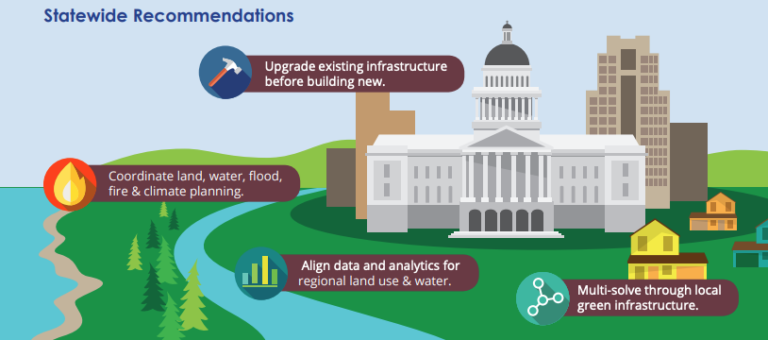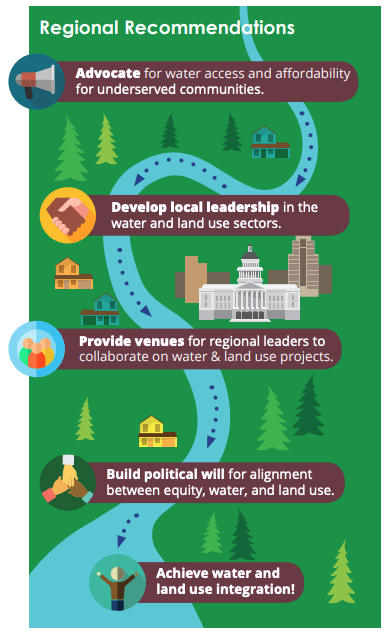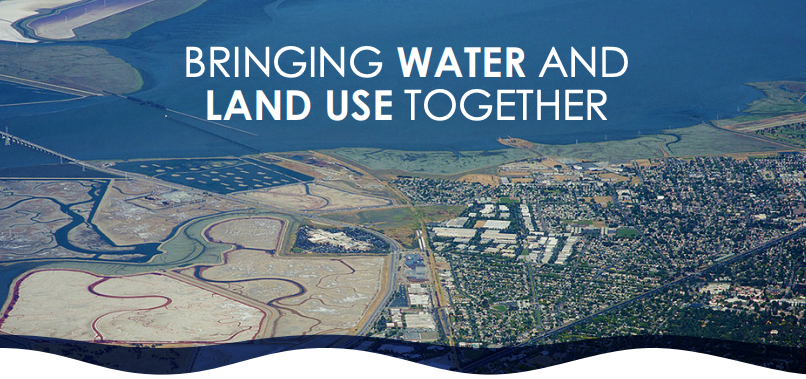California is moving toward a more holistic approach to managing our water and land resources as the 21st century unfolds.
In 2005, the California Legislature passed new laws that enable communities to join together to adopt Integrated Regional Water Management (IRWM) policies and practices. This comprehensive planning approach considers water resources in the context of an interconnected watershed with a network of regional governance, rather than as a combination of fragmented parts. Unfortunately, the IRWM program is dominated by the water sector and in most regions has not pursued alignment with land use.
Similarly, the Sustainable Communities Strategies (SCS) mandated through SB 375 establish a framework for aligning land use practices (predominantly housing and transportation) across jurisdictions within a larger geographic region. Yet very few SCSs have taken water resources into account.
While water management and land-use planning remain highly fragmented across the state, we are making progress toward a more integrated approach, especially when setting new state-level policies, regulations and guidance. The 2014 Sustainable Groundwater Management Act (SGMA) is a leap forward in this direction. For the first time, local land use agencies have an opportunity to be full partners with water agencies in shaping groundwater governance. It is too soon to determine how well these two sectors are integrating under SGMA, but early results are promising.
Defining Challenges, Identifying Opportunities
Our current system is failing us. The disconnect between how our communities are organized and how our natural resources are managed is not only inefficient, but harmful to people and nature. Reconnecting water and land use will ensure vibrant, resilient communities for all. Unfortunately, the disconnect is far more common across the country than the integrated approach we so desperately need.
The obstacles to better alignment are varied. Population growth and economic development drive political boundaries, institutions and policy. Water supply is critical for economic development, but water management tends to run on shorter cycles and in response to – not in collaboration with – economic and land-use planning. Strong Final Report to the Community Foundations Water Initiative on the Equitable Integration of Water and Land Use BRINGING WATER AND LAND USE TOGETHER BRINGING WATER AND LAND USE TOGETHER political forces behind housing, production and energy industries often conflict with ecological water supply and water quality needs. Those political boundaries and institutions are often at odds with interdependent hydrologic and ecologic functions. Despite the importance of integrated water management and land-use planning, these factors illustrate the difficulty in accomplishing this goal.
Policies that favor sprawl development, along with a lack of attention to the natural functions and limits of our environment, often lead to degraded ecosystems, unsustainable communities and exacerbated, disproportionate impacts on communities already experiencing disadvantages. Disregard for interconnected systems has led to segregation of land-use planning agencies and water management agencies statewide. Yet, there is a growing awareness and interest in alternative approaches, such as smart growth, integrated regional water management, green infrastructure and “multisolving.”
Inequities in Water & Land Use
The negative impacts of segregated and misaligned planning are not distributed evenly across California’s communities. Integrating water management and land-use planning is critically important to the resilience of our state, but must be achieved through actions that enhance equity.
Inequities arise in the context of all public services – here, they include toxic pollution that hovers over some neighborhoods because zoning codes allowed residential development next door to industrial facilities; residential water and wastewater pipes skirt a community because the city that provides the water and wastewater services chose not to annex the neighboring community; new towns sprout up where existing communities lack basic infrastructure.
Proper inclusionary planning and management gives a voice to all community members, and ensures equity across investments, benefits, and risks. Communities thrive when their needs are met, and when community members have a role in the decision-making processes that shape their neighborhoods.
Statewide Challenges
Leadership For Integrated Solutions
Overlapping jurisdictional boundaries and authority creates tension between sectors and limits the implementation of integrated solutions. Public and private entities compete with one another, instead of coordinating efforts to maximize overall and shared benefits. Developing a coalition of leaders for integration, both within and across each of California’s major regions, will help realign priorities, shift behavior, and change the existing segregated approach to planning.
Limited Natural Resources
California’s economy and population continue to grow at alarming rates. Some would argue that natural resource availability is keeping up with current demand, thanks to human ingenuity and advances in technology. Yet when communities in our state lack access to safe, reliable drinking water we clearly are not keeping up with demand. These resources are finite; we must correct our past failings and carefully manage them for future needs.
Water is a limited resource. California’s complex hydrology coupled with its incredibly fragmented water governance system limits how much water is available to each community at any given point in time. Conservation, efficiency and reuse enable regions to grow without increasing water demand and still provide a reliable supply to most of the state’s residents. Yet many underserved California communities face regular water shortages or water quality disruptions. If current water infrastructure is not adequately meeting the needs of all Californians, this begs the question of how the state will meet future demand.
Land is also a limited resource. Much of the state’s developable acreage is in high demand for future growth, which threatens the protection of agriculture, open space and natural ecosystems. Conversely, smart-growth practices and infill development that are designed with water wise practices in mind provide significant long-term benefits for community resilience and vibrancy.
Reaching A Shared Perspective
A critical component for effective coordination is establishing a set of shared principles, knowledge and thinking about problems and opportunities. Technical terminology can stand in the way of meaningful conversations, as shared language is essential to more informed decision-making. Although water and land use are intrinsically connected, they are often distinctly separate sectors among government agencies and officials who each have their own vocabulary, perspectives and beliefs. Traditional sector–based approaches threaten equitable, efficient water and land-use planning. This mindset is passed down through institutions, continuously impeding integrated planning efforts.
Regional Diversity
Efforts to integrate water and land use must be tailored to the specific needs and priorities of each region. No single, one-size-fits-all approach will succeed in every region. Important distinctions exist between regions that will affect the guiding principles and best practices of local water and land-use integration. The greatest variations between regions that impact water and land use integration include the following:
- Population density and related development patterns;
- overall cost of living;
- local water quality and supply factors; and
- current status of coordinated planning.
Each of these components are expanded on in the full report; these factors must be considered when determining the best opportunity for integration or specific recommendations to pursue.
Statewide Recommendations

This report is based on a review of existing literature, analysis of various policies, conversations with countless water and land-use experts, and an evaluation of the principles and opportunities outlined above. Four general recommendations emerged to provide opportunities that can significantly affect the potential success of integrating water management and land-use planning, while also being politically feasible in a number of situations.
Specific action at multiple scales is necessary to achieve progress on these recommendations. More context and activities for each recommendation are outlined further in the full report.
 Regional Recommendations
Regional Recommendations
Some actions are more effective when applied at the local or regional scale. To the left are four recommendations for community foundations, local agencies, and other interested parties to implement at the local level to achieve better integration of water and land use. As you can see from the graphic, these build on one another to achieve a common goal.
Signs of Hope
Despite the many challenges and barriers to integration, opportunities abound in the Golden State.
Policymakers and practitioners are beginning to acknowledge that something needs to change about our state’s water management and land-use planning.
California is at a critical juncture. Intense pressure for further development, shifting hydrologic and ecological conditions, and a new administration present both significant risk and opportunity. We as a state and within each region can either “get it right” by equitably integrating water and land use, leading to a more resilient and vibrant future for all, or “get it wrong” by maintaining the status quo, and perpetuating historic inequities and exacerbating the negative impacts of both climate change and sprawl development.
For more details on these recommendations, please see the full report at lgc.org/water-and-land-use.
This work was made possible through funding from the S.D. Bechtel, Jr. Foundation and facilitation by the Funder’s Network for Smart Growth and Livable Communities.


